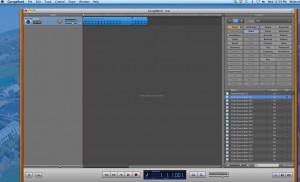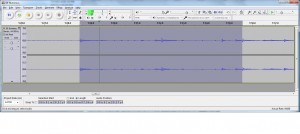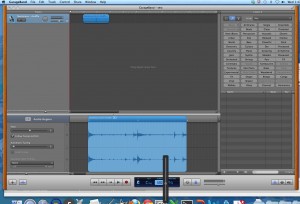Today’s post is rather geeky! Since for this year’s RPM Challenge I am working with a musical partner for the first time we decided to do our recording projects using Apple’s GarageBand. GB is fairly easy to use and at this point has been improved and cross-pollinated from Apple’s pro Logic app sufficiently to get decent results.
One of the functions that makes GB easy is Apple Loops. GB comes with a large collection of pre-recorded/programmed live and electronic (MIDI) snippets that can be dropped into your song project and then “dragged” with your mouse to duplicate as many times as you wish.In the screen shot below (click to enlarge) I have dragged the loop “club beat 001” from the list of loops at the bottom right into the track area in the middle, and when this was captured I was using my mouse to drag from left to right on the loop to cause it to start copying itself:
But suppose you want to create your own loops? First, a legal caveat: do NOT use music you did not create yourself unless you have obtained the rights to sample it! (Apple’s built-in loops are royalty-free for commercial use).
I wanted to loop a two measure drum shuffle from our Ginger Ibex song Numinous, which occurs at about 1:30 in a 6 minute song. To do this I needed to
1. Create a sound file (mp3/wav/aiff) containing only that part of the recording. While this could be done by importing the entire sound file into GB and editing there, I prefer to use the free app Audacity because it allows me to magnify the visualization of the sound file to select within milliseconds the part I want to use. In the screen shot below (click to enlarge) of the Numinous audio file in Audacity I have magnified the track to see the waveform in great detail, and have selected the two bars of drum shuffle.
2. Another handy feature of Audacity is that you can test your loop: in the upper left corner of the screen shot you will see the transport controls to pause-play-move-stop the audio playback. Note that the 2nd button in has a circular “looping” symbol instead of a “play” arrow – by holding the Shift button on your keyboard while clicking on the “play” arrow you tell Audacity to keep looping the selection. This allows you to hear what it sounds like so you can adjust the selection range if necessary to make it work.
3. Once you are happy with the selection choose File -> Export Selection and export it as an .mp3 file. Open a window to where you saved the file so you can see it.
4. In GarageBand, open a new project and drag the mp3 file you made into the track area to import it. Hit Command-E to open the audio editor in the bottom of the screen. Select Control->Show Tempo to set the box at the bottom to show the tempo.
5. Now you need to set the project to the approximate tempo of the file you imported.
– As in the screen shot below, center the waveform of the file in the audio editor so you can see it.
– Click on the Tempo to bring up a slider to change the tempo.
– Adjust the tempo until the waveform fits pretty exactly into the number of measures you expect (e.g., if it is a 2-bar phrase in 4/4 time it should start on the 1st beat of a bar and end at the 1st beat of the 3rd bar to the right)
6. With GB’s metronome on, play your track. It will probably not line up exactly with the metronome beats, especially if it is a live recording. Fortunately GB has a function called Quantize which will help you line up the beats. After clicking on the track to select it:
– in the bottom left “Audio Region” corner, check the box for Follow Tempo & Pitch
– Then in Quantize Note Timing select “1/1 Note”. You can try setting it to less than Max on the slider if it makes the track sound too mechanical, or try the other 1/x settings to really force it to conform.
7. Now that the loop sounds like what you want, under Edit choose Add To Loop Library, give it a name and genre, and save it.
Now you can use this loop for any project, as you would the built-in apps. And a bonus of saving it with Follow Tempo & Pitch is that this loop will now change tempo to whatever the tempo used in the project to which you add it!
If you found this article useful you may like my GarageBand Tips videos:
Quantizing in GarageBand – tighten up your not-quite-on-the beat tracks.
Using Automation in GarageBand – adjust the volume in certain portions of a track.
“Riding the Fader” in GarageBand – more about automation.




Help Betty! How do I export a loop as a midi-file (or export ANY midi file from Garageband?)
Unfortunately you can’t export as midi from Garagebsnd. You need to open the Garagebsnd file with Logic, and then you can export it as midi from there.